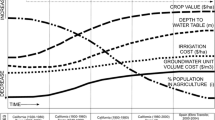Abstract
The political boundaries between the Palestinian and Israelismake the water issues critical and sensitive. Groundwater is theprimary source for the Palestinian in the West Bank. Although, there are many studies on the shared surface resources (Jordan River Basin), there are few studies on the groundwater shared resources between the Palestinians and Israelis.There are three primary groundwater basins underlying the West Bank (Eastern, Northeastern and Western Basins) as shown in Figure 1. Both the Northeastern and Western basins are shared between Israelis and Palestinians. The Palestinians have a limited access to the Northeastern Basin and strictly limited access to the Western Basin. In addition to the quantity of available water resources, thequality of water is emerging as a critical issue. Threats to ground water quality include disposal of untreated wastewater, increasing salinity due to agricultural activities and intrusion of native groundwater of poor quality. Widespread use of herbicides and pesticides also represent a threat to drinking water supplies.The Declaration of Principles, signed in Washington D.C in 1993,was a major step toward resolution of the political conflict between the Israelis and Palestinians. However, the water issue is part of the final status negotiations, which still unresolved.As resolution to political conflict is pursued, it is clear that water resources management issues remain at the forefront becauseof the transboundary nature of the hydrologic regime. Cooperative management on the technical level appears to be the only alternative to further conflict and degradation of the region's scare water resources. This article will study the impact of the transboundary resources on both sides and explore some of the most significant groundwater management issues facing both the Palestinians and Israelis.
Similar content being viewed by others
References
Benvenisti, E.: 1992, 'International Law and the Mountain Aquifer', in J. Issac and H. Shuval (eds), Proceeding of the First Israeli-Palestinian International Academy Conference on Water, 10-13 December 1992, Zurich, pp. 229-238.
CDM/Morganti: 1998, Sustainable Yield Study for the Eastern Basin, Ramallah, West Bank.
Deutsche Stiftung für Internationale Entwicklung (Foundation for International Development): 1998, Transboundary Water Management, Experience of International River and Lake Commissions, Berlin, Villa Borsig, 27-30 September 1998.
Gvirtzman, H.: 1992, 'Groundwater Allocation in Judea and Sameria', J. Issac and H. Shuval (eds), Proceedings of the First Israeli-Palestinian International Academy Conference on Water, 10-13 December 1992, Zurich, pp. 205-218.
Millinum Engineering: 2000, Groundwater Management Modeling Study for the Eastern Basin, Ramallah, West Bank.
Moore, J. W.: 1992, 'An Palestinian-Israeli Water Sharing Regime', J. Issac and H. Shuval (eds), Proceeding of the First Israeli-Palestinian International Academy Conference on Water, 10-13 December 1992, Zurich, pp. 181-192.
Palestinian Water Authority Database: 2000.
Author information
Authors and Affiliations
Rights and permissions
About this article
Cite this article
Froukh, L.J. Transboundary Groundwater Resources of the West Bank. Water Resources Management 17, 175–182 (2003). https://doi.org/10.1023/A:1024185822782
Issue Date:
DOI: https://doi.org/10.1023/A:1024185822782




